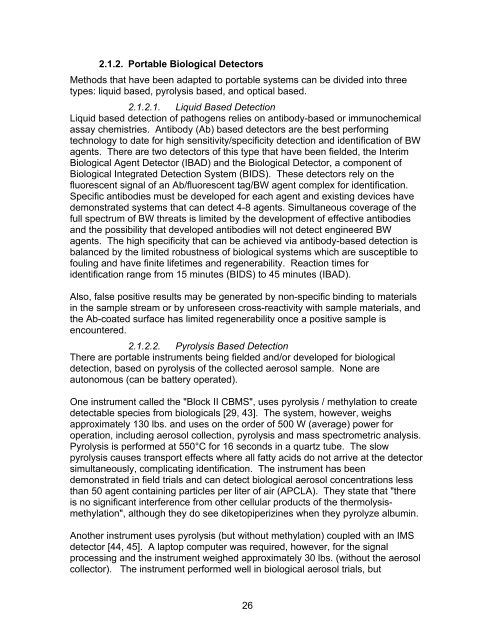Miniature Sensors for Biological Warfare Agents using Fatty Acid ...
Miniature Sensors for Biological Warfare Agents using Fatty Acid ...
Miniature Sensors for Biological Warfare Agents using Fatty Acid ...
You also want an ePaper? Increase the reach of your titles
YUMPU automatically turns print PDFs into web optimized ePapers that Google loves.
2.1.2. Portable <strong>Biological</strong> Detectors<br />
Methods that have been adapted to portable systems can be divided into three<br />
types: liquid based, pyrolysis based, and optical based.<br />
2.1.2.1. Liquid Based Detection<br />
Liquid based detection of pathogens relies on antibody-based or immunochemical<br />
assay chemistries. Antibody (Ab) based detectors are the best per<strong>for</strong>ming<br />
technology to date <strong>for</strong> high sensitivity/specificity detection and identification of BW<br />
agents. There are two detectors of this type that have been fielded, the Interim<br />
<strong>Biological</strong> Agent Detector (IBAD) and the <strong>Biological</strong> Detector, a component of<br />
<strong>Biological</strong> Integrated Detection System (BIDS). These detectors rely on the<br />
fluorescent signal of an Ab/fluorescent tag/BW agent complex <strong>for</strong> identification.<br />
Specific antibodies must be developed <strong>for</strong> each agent and existing devices have<br />
demonstrated systems that can detect 4-8 agents. Simultaneous coverage of the<br />
full spectrum of BW threats is limited by the development of effective antibodies<br />
and the possibility that developed antibodies will not detect engineered BW<br />
agents. The high specificity that can be achieved via antibody-based detection is<br />
balanced by the limited robustness of biological systems which are susceptible to<br />
fouling and have finite lifetimes and regenerability. Reaction times <strong>for</strong><br />
identification range from 15 minutes (BIDS) to 45 minutes (IBAD).<br />
Also, false positive results may be generated by non-specific binding to materials<br />
in the sample stream or by un<strong>for</strong>eseen cross-reactivity with sample materials, and<br />
the Ab-coated surface has limited regenerability once a positive sample is<br />
encountered.<br />
2.1.2.2. Pyrolysis Based Detection<br />
There are portable instruments being fielded and/or developed <strong>for</strong> biological<br />
detection, based on pyrolysis of the collected aerosol sample. None are<br />
autonomous (can be battery operated).<br />
One instrument called the "Block II CBMS", uses pyrolysis / methylation to create<br />
detectable species from biologicals [29, 43]. The system, however, weighs<br />
approximately 130 lbs. and uses on the order of 500 W (average) power <strong>for</strong><br />
operation, including aerosol collection, pyrolysis and mass spectrometric analysis.<br />
Pyrolysis is per<strong>for</strong>med at 550°C <strong>for</strong> 16 seconds in a quartz tube. The slow<br />
pyrolysis causes transport effects where all fatty acids do not arrive at the detector<br />
simultaneously, complicating identification. The instrument has been<br />
demonstrated in field trials and can detect biological aerosol concentrations less<br />
than 50 agent containing particles per liter of air (APCLA). They state that "there<br />
is no significant interference from other cellular products of the thermolysismethylation",<br />
although they do see diketopiperizines when they pyrolyze albumin.<br />
Another instrument uses pyrolysis (but without methylation) coupled with an IMS<br />
detector [44, 45]. A laptop computer was required, however, <strong>for</strong> the signal<br />
processing and the instrument weighed approximately 30 lbs. (without the aerosol<br />
collector). The instrument per<strong>for</strong>med well in biological aerosol trials, but<br />
26
















